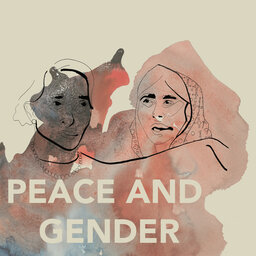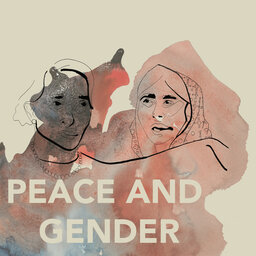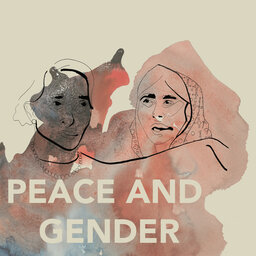In this episode of Peace and Gender, Andrea Thiis-Evensen meets up with Dr. Lesley Pruitt and Dr. Helen Berents to discuss why it is important to look at youth when talking about conflict, and how important it is to see past young people's gender when discussing migrants.
TRANSCRIPT
Andrea Thiis-Evensen: Hey, my name is Andrea Thiis-Evensen. Welcome back to Peace and Gender; a podcast for the people who are interested in learning a bit more about gender, peace and conflict.
A topic that’s come up a lot in this podcast is how they’re so many stereotypes regarding men and women, such as in militaries or in diplomacy. Today we will be looking at the gender stereotypes around young migrants.
Why are young migrant men seen as inherently dangerous, while young women are seen as victims? Why are so many young men fleeing their countries? Lesley Pruitt and Helen Berents have studied this and in today’s episode, they will discuss the importance of looking at young people when talking about conflict. Also how important it is to try and change the dialog - this gender stereotype dialogue around young migrants. Lesley is a senior lecturer at Monash University and Helen is a lecturer in the school of justice at Queensland University of Technology, but why did Lesley and Helen start studying youth conflict and peace building? Here is Helen.
Helen Berents: In some ways, to answer the question, I have to note that I lived overseas when I was a kid, with my family. We lived in Latin America; obviously in a very privileged position as ex-pats and I went to an international school. I think it was the first time that I kind of encountered very visibly these questions of inequality and confront ideas of poverty. I was quite young and thinking about all that meant. Being young and encountering people who were my age and in such different situations. How young people coped in those environments - I think kind of sat in the back of my head. As I got to do my honours and post-grad work, that was where my interests took me; because I couldn’t help but ask, why we weren’t talking about young people when we were talking about questions of inequality and questions of peace building and responding to violence. They’re always there when you look, and yet we don’t talk about them.
Andrea Thiis-Evensen: Here is Lesley.
Lesley Pruitt: I was a first generation high school graduate; neither of my parents finished school. Now being a PhD graduate is like a thing that I couldn’t have envisioned probably as a little child; I didn’t know anybody that had a PhD, maybe my school teachers I knew that had college degrees. What I did know and what I learned through that time with many amazing young people around me was that young people are interested; they’re engaged; they’re knowledgeable; and not just the young people who come from a background that expects them to excel academically or to engage in politics. All young people have various capacities for that and deserve to be listened to. That’s always been a passion of mine, is supporting young people in the next generation and thinking about how we can think together and how we can have intergenerational leadership to make the change that we need to affect society that’s more inclusive for everyone.
Andrea Thiis-Evensen: Why is it important to look at young people when it comes to conflict and peace?
Lesley Pruitt: Oh, we could be here all day Andrea.
[Laughter]
Lesley Pruitt: We are the people to ask about this; we are a very passionate about convincing people; especially in our fields and international relations, which often completely overlooks young people. Often pays no attention to them whatsoever or when it does, talks about them only under these tropes; these stereotypes; [unclear]; young people as perpetrators; and young people as victims. That - this idea that young people fall into one or the other of those and that’s where they stay. We and other scholars that are working on young people in peace and conflict studies and international relations are really invested in trying to work to change those views.
To recognise the [thorality] - the diversity of stories that come with young peoples’ lives. This is crucial and we can’t build a more peaceful world with better outcomes for everybody if we’re leaving out a huge proportion of the population. Simply, young people are people and they have a right to be heard and to participate. That’s really important to recognise and to support.
Helen Berents: I’m nodding furiously and realised that we’re recording a podcast so...
[Laughter]
Helen Berents: ...that’s not very helpful.
Lesley Pruitt: We do that to each other all the time.
Andrea Thiis-Evensen: That’s okay.
Andrea Thiis-Evensen: Both Helen and Lesley have studied youth in conflict. In 2010, Helen went back to Latin America.
Helen Berents: So I - as part of my PhD work, I spent four months in Colombia in 2010. I lived in Bogotá and I worked in a informal, illegal community that was on the outskirts of the city - actually in the neighbouring city but those communities blend into one another. This is a community of predominately internally displaced people who are very poor; who came to this community over the last few generations. So it’s a legal community originally; they’re slowly gaining rights to their land. I worked there through a foundation that supported a school in that site. I’d spend about four days a week on average for those four months basically hanging out in the community; talking to young people; helping out at the school; hanging out with families; and just spending time with them to understand what goes on in their life.
This is - I mean I say it’s not truly ethnographic in the anthropological sense perhaps, but drawing on that training and that knowledge to really try and understand their lives and the context of their life. Rather than just dropping in and interviewing them, and disappearing to really understand what’s going on around them when they’re talking to me about things. So I understand the context.
Andrea Thiis-Evensen: Both Lesley and Helen believe it’s important to look at young people when talking about displacements and when talking about the European migration crisis.
Lesley Pruitt: What we’re seeing today - in the past several years is the largest displacement of people from conflicts since World War II. That gets bandied about, but it bears repeating. It is an anomaly in that sense even though this is an issue that’s going on all the time. Maybe in that sense, what people might only see as a crisis now has been a crisis for many people in their lives for decades or for their lifetime. I guess it’s just to take the opportunity with the attention that is available to this to say hey, yeah as we’ve been saying [laughs] this is important so how can we think about what experiences young people are having.
In this particular situation of conflict related migration, we’re looking specifically at the European context where there’s been a great deal of attention to the fact that the majority of people migrating and seeking asylum in this context are overwhelmingly young and disproportionately male in this case. That’s really brought about a lot of interest from policy makers who have particular views on that and leverage that in the way they talk about it to particular political ends.
Andrea Thiis-Evensen: Lesley and Helen recently wrote an article about this with their colleague Gayle Munro called Gender and Age in the Construction of Male Youth in the European Migration Crisis.
Helen Berents: I think what the co-called European refugee crisis - and I’m using air quotes even though we’re on the radio.
Andrea Thiis-Evensen: [Laughs].
Helen Berents: Is the fact that they, as you say, are young men and the kind of coverage that has come about, about this and the attention that’s been given to it, draws upon these long held stereotypes that Lesley and I both looked at in various work right there. Young men - particularly young men in places that are affected by conflict are inherently violent; they’re pre-disposed to joining gangs; they are going to cause problems. I think often bandied about and not fully understood flawed proposition of the youth bold trait; that when there’s more young people, particularly young men, the country is more likely going to end up in conflict despite repeatedly proving that that’s not the case. These become really dominant narratives in policy making and in public discourse about this kind of events.
I think what the European refugee crisis - so-called - really brought home is that when we see these people arriving in, quote unquote, global north countries and the problem arrives quote on our shores. Suddenly then how we talk about and engage with these populations that are coming.
Andrea Thiis-Evensen: The discourse around peace and conflict is very often gendered, in the way that young men are seen as threats while young women are seen as victims. This is what Helen and Lesley looks at in their article.
Lesley Pruitt: I guess firstly, there’s a lot of different kinds of feminism; so this is not to speak for all feminists. I would think its part of our shared feminist project is partly denaturalising assumptions about gender. So what were critiquing here is especially about these ideas that young men are inherently naturally like this; these sort of biologically determinist arguments. Of course we think young men and young women and people who might not identify as others, have a whole lot of different options or ways that they might feel or experience and do. At the same time as acknowledging - as I’ve found in my research and field work with young people in a variety of conflict affect context that there is a lot of pressure on young men in these settings.
In other settings, to participate in violence; and a lot of danger sometimes if they refuse to participate in that. That’s one of the key points that we keep reiterating is that often why they’re being seen in a threat in this case is actually why they’re under threat somewhere else. They’re trying to flee from being forced into that in many context and then being treated as a threat on arrival which has implications.
Andrea Thiis-Evensen:Helen has also seen this gender discourse around young migrant men at the US Boarder.
Helen Berents: In some work that I’d been doing with a colleague looking at the US Boarder and young migrants coming up through Central America. As Lesley pointed out before, this is a classic example. The reason that they are overwhelming young men coming in is because in their home countries they are the most vulnerable to recruitment by the gangs; by the [maras]; by whatever’s going on in their home country. When they arrive at the boarder they are the most threatening category of migrant who arrive.
Andrea Thiis-Evensen: So young migrant men are seen as a threat, while they are the ones in many ways are extremely vulnerable in their home country. When they arrive in a new country they are seen as inherently dangerous while they are actually fleeing from something dangerous back home. This happens just because of their gender; because they’re men. I asked Lesley if there’s any specific examples of this.
Lesley Pruitt: Well one of the examples that we used in our paper and that you see common in foreign policy - going back to this youth bulge idea which we’re critical of. We’ve got colleagues who have written about how, quote unquote, military age males; young men are routinely excluded from civilian death counts for example, by the US. You’ve seen this phrase used in the news in recent years; we use an example in our paper from a military guy who in Fox News was using this phrase saying no military age males should be allowed in; he said that’s a Trojan horse. It was like, we have to protect our country and to do that we cannot let any young men in.
It sort of equated that if you were a young man and you’re in this age, you’re inherently a danger and threat. We have to keep that - and we see that discourse being really common in popular eyes. It’s sort of drawing on this demographic difference in this migration about how it is disproportionately young and male; that people are leveraging that to these political ends. It’s coming up loads and loads of times in the media. I think really different to some previous reports and different contexts where refugees were often referred to as women and children, which was used to shorthand innocent. In this way is being used to shorthand dangerous. Both of those are oversimplifications and need to be rethought.
Andrea Thiis-Evensen: The news is important to look at when it comes to this stereotype gender discourse as well. Helen and Lesley start their article with looking at what happened when the image of Syrian boy Alan Kurdi went viral in the news.
Lesley Pruitt: You may remember Alan Kurdi was this small child - a toddler - a Syrian who was fleeing and his family hoped to be able to migrate to Canada. Which at the time, policy wise was very unlikely that that would be possible but they had family there. That was their hope and their intention. This child drowned at sea and washed up onto shore. The picture was taken and that picture went viral. First there was the reaction where there was this global sense of somebody has to do something. There are actually policies changes around that. I think that’s been credited in a variety of ways of changing the Canadian government at the time, which was the perceived or the intended host country I guess for this family, did change policy to make it more open and did intake more Syrian refugees.
You had the opening of the boarders in Germany; you had these various reactions. Then also within this very short period of time that you had these outlets putting these things like these cartoons saying - using this child’s image to say, well eventually he would have done this, so we have to keep these men out. That for us was this sort of problematic - was like, how does that sentiment in the press; or how does that sentiment in the public shift so quickly from, oh this is a huge problem we have to do something about it to this is a huge problem and we have to keep everybody out. We’re interested in what is the language; what are the narratives. For us we saw there was this real common dynamic that the way that that worked was through saying - focusing on these demographics around this being young men and referring back again and again to how young men must be dangerous.
Andrea Thiis-Evensen: That was Lesley Pruitt and Helen Berents. Thank you so much for listening to this episode to Peace and Gender. My name is Andrea Thiis-Evensen and this podcast was produced for Monash Gender, Peace and Security and Mojo News.
Music: "Solitude" by Broke for free – Creative Commons Attribution-NonCommercial-
Artwork: Shayla Rance
 Peace and Gender
Peace and Gender

